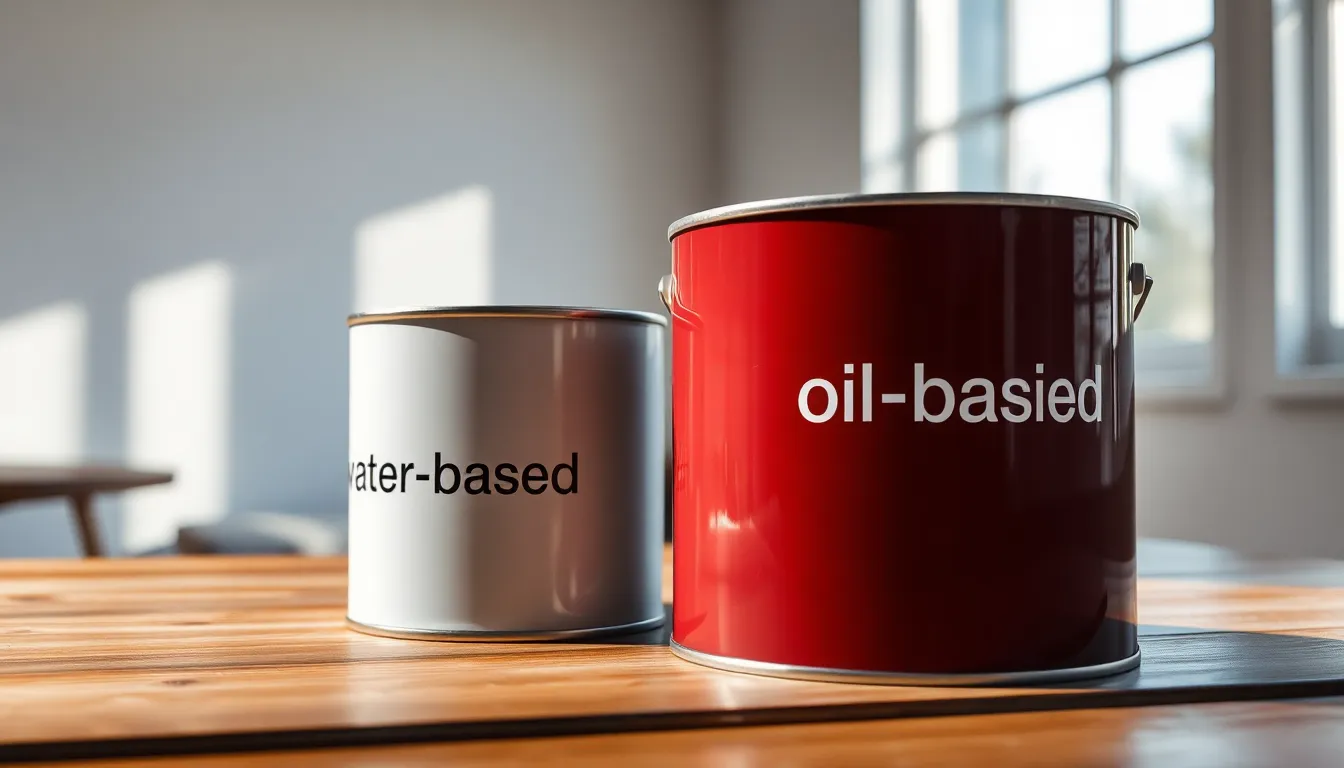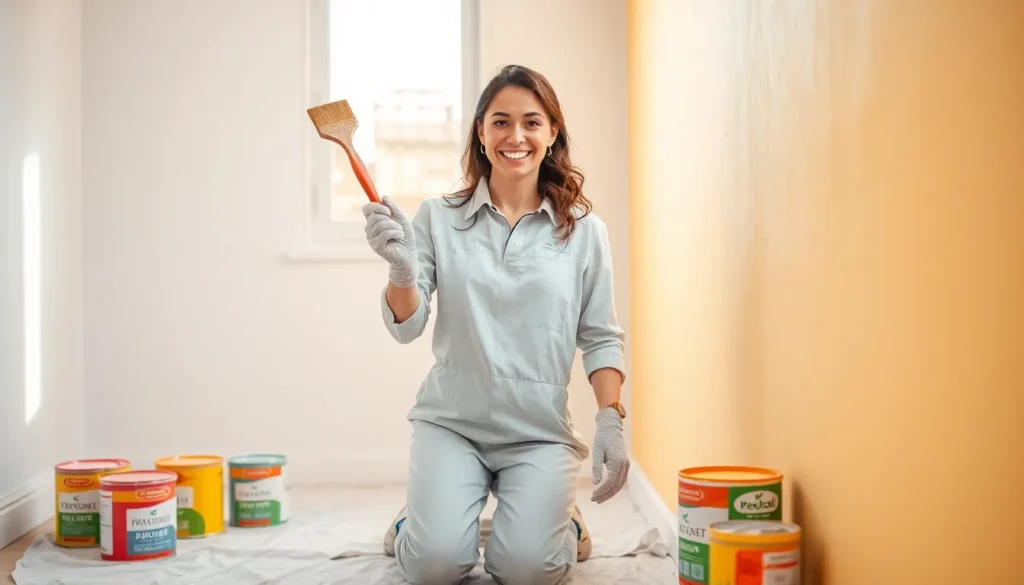Transforming a space often starts with a fresh coat of paint. Interior painting not only revitalizes walls but also sets the mood and enhances the overall aesthetic of a home. Whether it’s a cozy living room or a vibrant kitchen, the right color can breathe new life into any area, making it feel more inviting and personal.
Choosing the perfect paint involves more than just picking a color. Factors like finish, durability, and the psychological effects of colors play a crucial role in achieving the desired outcome. With a bit of planning and creativity, anyone can master the art of interior painting, turning their vision into reality. Dive into the world of interior painting and discover how to elevate your home’s ambiance with just a brushstroke.
Table of Contents
ToggleOverview of Interior Painting
Interior painting revitalizes spaces, enhancing both aesthetic appeal and emotional atmosphere. Choosing the right paint involves various considerations, including color selection, finish type, and durability. Color choices can influence feelings and perceptions, making them significant in the painting process.
Factors influencing paint selection include:
- Color: Bright hues can energize spaces, while muted tones provide calm. The selection impacts how light interacts with surfaces.
- Finish: Different finishes, such as matte, satin, or gloss, affect look and maintenance requirements. Each finish serves unique purposes; for example, gloss finishes are easier to clean.
- Durability: High-quality paints resist wear over time. Considerations like washability and fade resistance are crucial for long-lasting results.
Planning interior painting projects promotes successful outcomes. Measurement and preparation are essential for achieving desired results. Gathering necessary tools, such as brushes, rollers, and painter’s tape, can streamline the process. Understanding techniques like proper layering and application methods ensures an even finish.
Ultimately, the art of interior painting provides a powerful means of personal expression. Through thoughtful selection and execution, individuals can transform their environments and create inviting, beautiful homes.
Types of Interior Paint

Selecting the right type of interior paint is crucial for achieving the desired look and durability. Two primary types are commonly used: water-based paint and oil-based paint.
Water-Based Paint
Water-based paint, also known as latex paint, consists of water as the primary solvent. It offers several advantages, including low levels of volatile organic compounds (VOCs), making it better for indoor air quality. Water-based paints dry quickly, usually within one to two hours, allowing for faster project completion. Their finish options range from matte to semi-gloss, accommodating various aesthetic needs. They adhere well to most surfaces and enable easy cleaning with soap and water.
Oil-Based Paint
Oil-based paint uses oils, such as linseed or mineral spirits, as a solvent. This type of paint is known for its durability and smooth finish, ideal for high-traffic areas and surfaces requiring extra resilience. Oil-based paints take longer to dry, often needing up to 24 hours, allowing for a slower application process that can be beneficial for blending and layering colors. They generally provide a glossy finish, which can enhance colors but requires strong solvents for cleanup. Due to higher VOC levels, proper ventilation is essential during application.
Tools and Equipment for Interior Painting
Interior painting requires specific tools and equipment to ensure a smooth and efficient process. Utilizing the right items enhances the quality of the finish and contributes to a safer working environment.
Essential Painting Tools
- Paintbrushes: Various sizes and shapes help reach different areas. Synthetic brushes work well with water-based paints, while natural bristle brushes suit oil-based options.
- Rollers: Use rollers for large flat surfaces. Choose a roller nap thickness based on the surface texture. Short naps work for smooth walls, while longer naps handle rough surfaces.
- Painting Tray: A tray holds paint for easy access with brushes and rollers. It simplifies the application process and minimizes mess.
- Painter’s Tape: Painter’s tape protects edges and prevents paint from bleeding onto adjacent surfaces. A clean line is crucial for a professional finish.
- Drop Cloths: Cover floors and furniture with drop cloths to catch spills and splatters. Canvas cloths are more durable than plastic options.
- Ladder: Use a sturdy ladder for reaching high areas. Ensure it’s stable and positioned safely before painting.
- Sanding Tools: Sandpaper or sanding blocks prepare surfaces by smoothing rough areas and removing old paint. This step promotes paint adhesion.
Safety Gear
- Dust Mask: A dust mask protects against inhaling harmful particles, especially during sanding. Choose a mask that fits properly to ensure maximum protection.
- Safety Goggles: Goggles safeguard eyes from dust and paint splashes. Ensure they fit comfortably for extended use.
- Gloves: Use disposable or reusable gloves to protect skin from paint and chemicals. Choose gloves made from latex, nitrile, or vinyl based on personal preference.
- Coveralls: Wear coveralls to protect clothing. These can also minimize skin exposure to paint splatters.
- Ear Protection: If using power tools, include ear protection to prevent hearing damage. Choose comfortable options for prolonged use.
Utilizing these tools and gear ensures efficiency and safety in interior painting projects.
Preparing for Interior Painting
Preparing for interior painting requires careful attention to detail to ensure a successful outcome. This process involves thorough surface preparation and thoughtful color selection.
Surface Preparation
Surface preparation holds critical importance in achieving a flawless paint job. Cleaning walls removes dirt, grease, and dust that could hinder paint adhesion. Patching holes and cracks enhances the surface’s smoothness. Sanding these areas provides a level base for paint application. A primer’s use promotes better coverage and can block stains, ensuring the true color of the topcoat shines through. Finally, removing switch plates and covering furniture with drop cloths protects belongings and prevents overspray, facilitating a neat painting environment.
Choosing the Right Colors
Choosing the right colors significantly impacts the final appearance and atmosphere of a room. Consider the room’s purpose; vibrant colors often energize, while muted shades evoke calmness. Test samples on walls to see how they look in different lighting throughout the day. Analyze how colors interact with existing furnishings and decor. Utilizing a color wheel can help find complementary shades. It’s essential to account for finish types, as gloss offers a reflective quality and durability, whereas matte provides a softer appearance. Thoughtful color selection fosters the desired ambiance, making spaces feel welcoming and personalized.
Techniques for Interior Painting
Mastering various techniques enhances the quality and efficiency of interior painting projects. Familiarity with different application methods ensures an even finish and professional appearance.
Brush Techniques
Brush techniques play a crucial role in achieving detailed finishes and painting corners or edges.
- Cutting In: This technique involves using a brush to paint edges along baseboards, ceilings, and corners.
- Wrist Control: Maintaining a steady wrist allows for smoother lines and reduces the chance of drips.
- Using the Right Brush: Selecting the appropriate brush size and type, such as angled brushes for trim or flat brushes for walls, ensures precision.
- Feathering: This technique blends the painted area with the surrounding surface to create a seamless look by lightly brushing the edges of freshly painted spots.
- Multiple Coats: Applying multiple thin coats instead of one thick coat provides a more uniform finish and ensures better coverage.
Roller Techniques
Roller techniques facilitate painting large surface areas efficiently while maintaining a consistent texture.
- Choosing the Right Roller: Selecting the correct nap length based on the surface texture ensures even application. Short naps work well on smooth surfaces, while longer naps are better for textured surfaces.
- Loading the Roller: Properly loading the roller with paint allows for an even spread, reducing streaks and ensuring all areas get sufficient coverage.
- Using an Extension Pole: An extension pole makes painting ceilings and high walls easier, reducing the need for ladders.
- Rolling Technique: Using the “W” or “M” technique when applying paint helps distribute it evenly across the surface before filling in.
- Laying Off: After rolling, lightly going over the painted surface with a clean roller helps smooth out any imperfections and achieves a uniform finish.
Interior painting offers a unique opportunity to transform living spaces and express personal style. By understanding the nuances of color selection and finish types, individuals can create environments that resonate with their desired atmosphere. Proper preparation and technique play crucial roles in achieving a professional-looking result that stands the test of time.
Investing in high-quality materials and tools ensures durability and enhances the overall painting experience. With thoughtful planning and creativity, anyone can revitalize their home through the art of interior painting. Embracing this process not only beautifies spaces but also contributes to a more inviting and enjoyable living environment.



